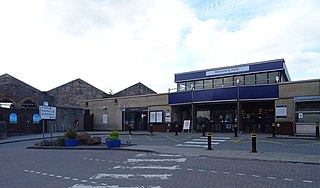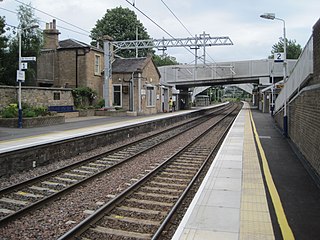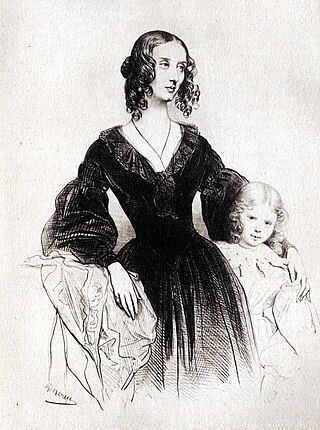
Railway Mania was a stock market bubble in the rail transportation industry of the United Kingdom of Great Britain and Ireland in the 1840s. It followed a common pattern: as the price of railway shares increased, speculators invested more money, which further increased the price of railway shares, until the share price collapsed. The mania reached its zenith in 1846, when 263 Acts of Parliament for setting up new railway companies were passed, with the proposed routes totalling 9,500 miles (15,300 km). About a third of the railways authorised were never built—the companies either collapsed because of poor financial planning, were bought out by larger competitors before they could build their line, or turned out to be fraudulent enterprises to channel investors' money into other businesses.
William Hutchison Murray, was a Scottish mountaineer and writer, one of a group of active mountain climbers, mainly from Clydeside, before and just after World War II.

Alyn Edward Smith is a Scottish politician. A member of the Scottish National Party (SNP), he served as the Member of Parliament (MP) for Stirling from 2019 until 2024 when he unsuccessfully stood for the Stirling and Strathallan seat. He also served as a Member of the European Parliament (MEP) for Scotland from 2004 to 2019. He has been serving as SNP Spokesperson for Europe and EU Accession since December 2022.

The North British Railway was a British railway company, based in Edinburgh, Scotland. It was established in 1844, with the intention of linking with English railways at Berwick. The line opened in 1846, and from the outset the company followed a policy of expanding its geographical area, and competing with the Caledonian Railway in particular. In doing so it committed huge sums of money, and incurred shareholder disapproval that resulted in two chairmen leaving the company.

Perth railway station is a railway station located in the city of Perth, Scotland, on both the Glasgow to Dundee line and the Highland Main Line. It is managed by ScotRail, who provide almost all of the services.
James "Jim / Fritz / Jock" Gerard McLaren is a Scottish dual-code international rugby league and rugby union footballer. He played representative level rugby league (RL) for the Scotland national rugby league team, and at club level for Wakefield Trinity Wildcats, and representative level rugby union (RU) for the Scotland national rugby union team, as a centre, and for Glasgow Warriors and Caledonia Reds.

The Monkland Canal was a 12+1⁄4-mile-long (19.7 km) canal designed to bring coal from the mining areas of Monklands to Glasgow in Scotland. In the course of a long and difficult construction process, it was opened progressively as short sections were completed, from 1771. It reached Gartcraig in 1782, and in 1794 it reached its full originally planned extent, from pits at Calderbank to a basin at Townhead in Glasgow; at first this was in two sections with a 96-foot (29 m) vertical interval between them at Blackhill; coal was unloaded and carted to the lower section and loaded onto a fresh barge. Locks were later constructed linking the two sections, and the canal was also connected to the Forth and Clyde Canal, giving additional business potential.

Polmont railway station is a railway station serving the village of Polmont, Scotland as well as the other Falkirk Braes villages. It is located on the Glasgow to Edinburgh via Falkirk Line and is also served by ScotRail services from Edinburgh to Stirling and Dunblane. It is the nearest station to much of the town of Grangemouth.

Stirling railway station is a railway station located in Stirling, Scotland. It is located on the former Caledonian Railway main line between Glasgow and Perth. It is the junction for the branch line to Alloa and is also served by trains on the Edinburgh to Dunblane Line and long-distance services to Dundee and Aberdeen and to Inverness via the Highland Main Line.
The Scottish Central Railway was formed in 1845 to link Perth and Stirling to Central Scotland, by building a railway line to join the Edinburgh and Glasgow Railway near Castlecary.

The Stirling and Dunfermline Railway was a railway in Scotland connecting Stirling and Dunfermline. It was planned by the Edinburgh and Glasgow Railway to get access to the mineral deposits on the line of route, but also as a tactical measure to keep the rival Caledonian Railway out of Fife.
The Wishaw and Coltness Railway was an early Scottish mineral railway. It ran for approximately 11 miles from Chapel Colliery, at Newmains in North Lanarkshire connecting to the Monkland and Kirkintilloch Railway near Whifflet, giving a means of transport for minerals around Newmains to market in Glasgow and Edinburgh.
The Forth and Clyde Junction Railway was a railway line in Scotland which ran from Stirling to Balloch.

Caledonia Reds were a Scottish rugby union team. They participated in two seasons of the Heineken Cup. They evolved from one of the traditional four amateur districts of Scotland, North and Midlands, in 1996.

Jean ("Jane") Wilhelmina Stirling was a Scottish amateur pianist who is best known as a student and later friend of Frédéric Chopin, who dedicated Nocturnes, Op. 55 to her. She took him on a tour of England and Scotland in 1848, and took charge of the disposal of his effects and manuscripts after his death in 1849.
Vale of Bannock Football Club was a Scottish association football club based in the town of Bannockburn, Stirlingshire.
Campsie Football Club was a Scottish association football club based in the village of Lennoxtown, Stirlingshire.
Redding Athletic Football Club was a Scottish association football club based in the village of Redding, Stirlingshire.

Dr Elspeth King is a Scottish curator, writer and social historian. She is known for her role as curator of social history at the People's Palace Museum in Glasgow, as Director the Stirling Smith Art Gallery and Museum, and for her scholarship on the Scottish Suffrage movement.
The 2019 Scottish Women's Premier League Cup was the 18th edition of the Scottish Women's Premier League's league cup competition, which began in 2002. It was sponsored by the Scottish Building Society and officially known as the Scottish Building Society Scottish Women's Premier League Cup. The competition was contested by all 16 teams of the two divisions of the Scottish Women's Premier League.










